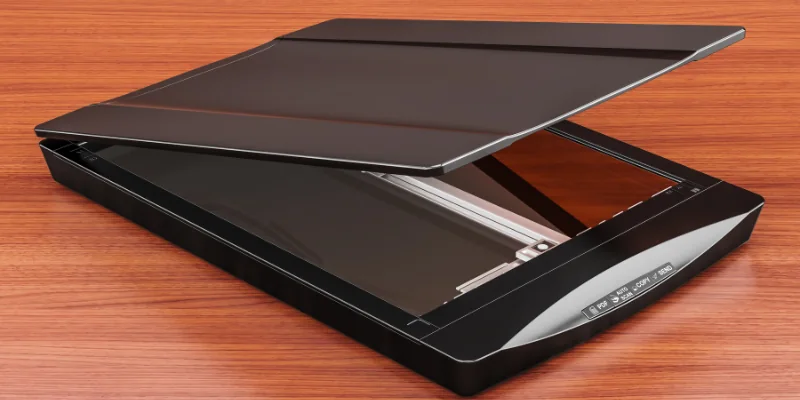Scanner Bring Life to Paper Instantly
Published: 9 May 2025
Did you know that Scanners have been around since the 1950s? These devices help convert physical documents, photos, and even film into digital files. Whether you’re preserving old memories or digitizing office paperwork, scanners play a crucial role in making information easily accessible and shareable. But what exactly is a scanner, and how does it work? Let’s explore the Scanner.
Introduction
A Scanner is a device that converts physical documents, photos, or images into digital files. It captures details using light and sensors, then saves the scanned file in formats like PDF, JPEG, or PNG. Scanners are commonly used in homes, offices, and businesses to digitize important papers and images for easy storage and sharing.
Importance of Scanners?
Scanners are essential for digital storage, organization, and easy access to documents. Here’s why they matter:
- Digitization: Converts physical documents into digital formats.
- Preservation: Saves old photos, books, and records from damage.
- Business Efficiency: Helps companies manage paperwork and store files securely.
- OCR Technology: Allows scanned text to be edited and searched.
- Eco-Friendly: Reduces paper use, helping the environment.
- Easy Sharing: Digital files can be emailed or uploaded instantly.

How Does a Scanner Work?
A scanner captures and converts physical documents into digital files. Here’s how it works:
- Document Placement: The paper or photo is placed on the scanner bed or feeder.
- Illumination: A light source shines over the document to highlight details.
- Image Capture: Lenses and image sensors (CIS or CCD) detect and capture the document’s details.
- Signal Processing: The captured data is converted into digital signals.
- File Storage: The scanned document is saved as a PDF, JPEG, PNG, or other formats on a computer or cloud service.
Types of Scanners
- Flatbed Scanner: A versatile scanner with a glass surface, ideal for documents and photos.
- Sheet-fed Scanner: Feeds paper through the scanner automatically, great for bulk scanning.
- Handheld Scanner: A portable device that scans by moving it over the document.
- Photo Scanner: Designed for high-quality photo scanning with better color accuracy.
- Film/Slide Scanner: Specially made for scanning film negatives and slides.
- Barcode Scanner: Reads barcodes to retrieve product or inventory information.
- 3D Scanner: Captures the shape and details of objects in three dimensions.
Applications of Scanners
- Office Use: Scans invoices, contracts, and documents for digital storage.
- Education: Converts handwritten notes and books into digital files.
- Healthcare: Scans medical records, prescriptions, and X-rays for better patient management.
- Photography & Art: Digitizes old photos, artwork, and film negatives.
- Retail & Inventory: Barcode scanners track products and manage stock efficiently.
- Legal & Government: Scans official documents for record-keeping and security.
- Banking & Finance: Used for scanning checks, IDs, and financial documents.
- Publishing & Printing: Helps in digitizing books, newspapers, and magazines.
- Real Estate: Scans property documents and blueprints for easy reference.
- 3D Modeling: 3D scanners capture objects for design, gaming, and manufacturing.
| Advantages of Scanners |
|---|
|
| Disadvantages of Scanners |
|---|
|
Yes! You can use apps like CamScanner, Adobe Scan, or Microsoft Lens to scan documents using your phone’s camera. These apps even let you save and share scanned files as PDFs or images.
A flatbed scanner is the best choice for home use. It’s great for scanning photos, documents, and even books. If you need to scan multiple pages quickly, a sheet-fed scanner is a better option.
Scanners use OCR (Optical Character Recognition) technology to recognize text in images. This allows scanned documents to be converted into editable text files. OCR is useful for digitizing books, notes, and printed documents.
Most scanners can save files as PDF, JPEG, PNG, and TIFF. PDF is best for documents, while JPEG is great for photos. Some scanners also support editable Word files if they have OCR.
No, most scanners work offline when connected to a computer via USB. However, some modern wireless scanners can send files directly to email, cloud storage, or mobile devices using Wi-Fi.
Make sure the scanner glass is clean and dust-free. Place the document flat and adjust the settings for higher resolution if needed. For text, use black-and-white mode to improve clarity.
A scanner creates a digital copy of a document, while a photocopier makes a physical paper copy. Some printers have built-in scanners, allowing you to scan and print documents easily.
A good scanner can last 5-10 years with proper care. Keeping it clean and using it regularly helps maintain performance. Avoid placing heavy objects on the scanner glass to prevent damage.
Yes! A flatbed scanner is the best way to scan old photos without damage. Use a soft brush to remove dust before scanning, and choose a high-resolution setting for the best results.
No, budget scanners start at around $50-$100, while high-end professional scanners can cost hundreds of dollars. Choose a scanner based on your needs—basic models work fine for home use, while offices may need faster, high-quality scanners.
Conclusion
So guys, in this article, we’ve covered what a scanner is in detail. Choosing the right scanner depends on your needs, if you scan documents daily, go for a high-speed sheet-fed scanner; if you need high-quality images, a photo scanner is your best bet. Investing in the right one can save you time and effort. Have questions? Drop them in the comments, and I’ll be happy to help!

- Be Respectful
- Stay Relevant
- Stay Positive
- True Feedback
- Encourage Discussion
- Avoid Spamming
- No Fake News
- Don't Copy-Paste
- No Personal Attacks

- Be Respectful
- Stay Relevant
- Stay Positive
- True Feedback
- Encourage Discussion
- Avoid Spamming
- No Fake News
- Don't Copy-Paste
- No Personal Attacks
